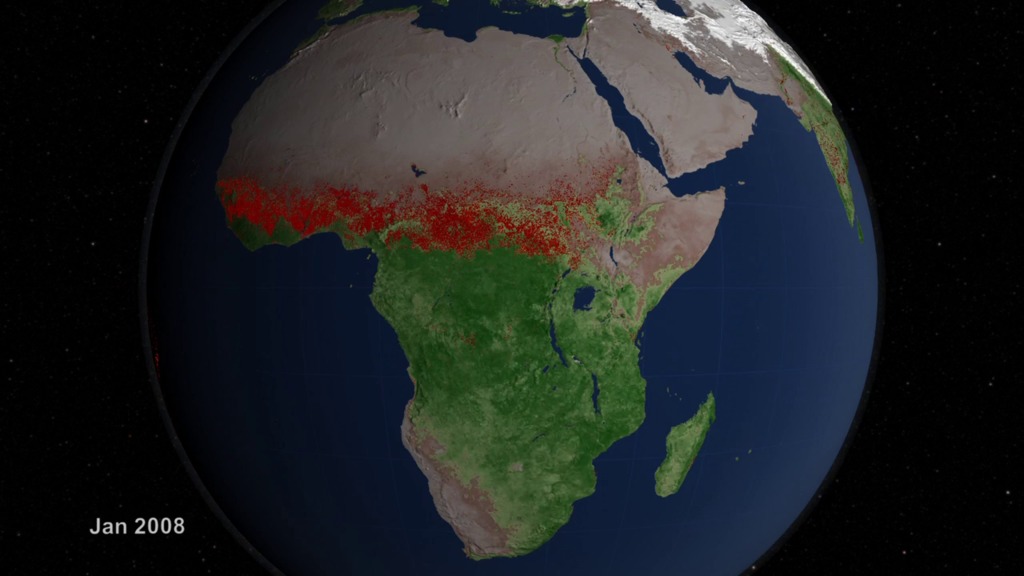The Geography Of Fire
What do nearly ten years of satellite fire observations look like? Instruments on two NASA Earth-observing satellites have answered that question by scanning the surface for signs of fire four times a day since 2002. The instruments have generated an ever-growing string of data that researchers have used to map the distribution of the world's fires in unprecedented detail. The visualization below provides a global tour of these observations using red to indicate actively burning fires, green to show vegetation and white to show snow. It begins with heavy grassland fires that speckle the dry interior of Australia in 2002. The view then pans to Asia and fire-prone Africa where waves of agricultural and management fires sweep across large portions of these continents in sync with seasonal surges of vegetation and retreating snow. A glimpse of a mild South American fire season in 2009 follows, along with intermittent flashes from wildfires that ravaged areas of Texas in the spring of 2011. Such data has more than aesthetic value: scientists use it to track fire trends over time and to refine calculations that show how greenhouse gases and particles emitted by fires in different regions contribute to climate change.

Watch nearly a decade of burning from a satellite's perspective.
Seventy percent of land charred by fire each year occurs in Africa. Australia sees about 14 percent of the world's burning and Asia 8 percent.
University of Maryland scientist Chris Justice points out that some fires help sustain healthy ecosystems.

Droughts fueled deadly fires in southeastern Australia in 2009. The brightest fires are shown in yellow, dimmer fires in red.

Despite intense burning seasons, African fires leave little carbon in the air because of all the carbon fast-recovering vegetation recycles.

Fires in equatorial Asia, in contrast, leave large amounts of carbon in the air because of the carbon-rich peat soils that often burn.

While burning in Africa tends to be consistent from year to year, fire activity in the boreal forests of Asia is sporadic.

Regulations have slowed clear-cutting of the Amazon forest, but fire activity has still gone up in many areas due to agricultural activity.

Despite increases in large wildfires in the American West, only about 2 percent of the land burned in the last decade has occured in North America.
Credits
Please give credit for this item to:
NASA's Goddard Space Flight Center
Photograph of burning fields courstery of Research Scientist Jessica McCarty (Michigan Tech Research Instistute).
-
Animator
- Lori Perkins (NASA/GSFC)
-
Video editor
- Kayvon Sharghi (USRA)
-
Interviewees
- Chris Justice (University of Maryland)
- Amber Soja (NASA/LaRC)
- Jim Randerson (University of California, Irvine)
-
Narrator
- Jefferson Beck (USRA)
-
Producer
- Kayvon Sharghi (USRA)
-
Scientists
- Chris Justice (University of Maryland)
- Louis Giglio (SSAI)
- Luigi Boschetti (University of Maryland College Park)
-
Videographer
- Rob Andreoli (Advocates in Manpower Management, Inc.)
-
Writer
- Adam P Voiland (Wyle Information Systems)
Release date
This page was originally published on Tuesday, November 1, 2011.
This page was last updated on Wednesday, May 3, 2023 at 1:53 PM EDT.
